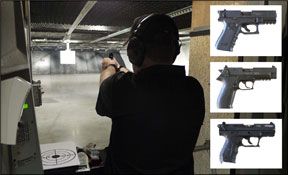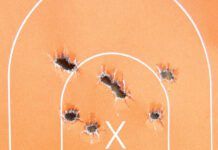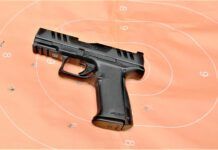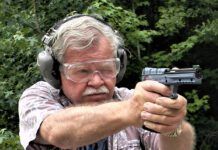As ammo prices continue to rise and availability remains spotty, more and more firearm enthusiasts are looking for less costly ways to extend their time on the shooting range. A natural solution is the 22 rimfire cartridge. Besides its cheaper price and greater availability, the recoil-friendly round makes it an excellent choice for those who are new to firearms. It’s also a good choice as a training round for experienced shooters looking to refine their technique.

Some manufacturers have begun to recognize this trend, and have begun manufacturing models designed to meet this new demand. We recently evaluated three AR-style rifles chambered in 22 LR in the February 2010 Issue. This month we decided to look at three semiautomatic pistols which could function as low-cost shooting trainers.
One model, the single-action-only ISSC M22, $400, has been specifically marketed as a training gun. Our other two models for this evaluation were double action/single models: the full-size SIG Mosquito ($390) and the smaller-framed but ample Walther P22 ($400). All three models shared some common features: blowback operated, ambidextrous safety levers, adjustable sights, and magazine disconnects. All three also had internal key-activated safeties. The P22 and M22 had one other thing in common—the same inventor, Austrian designer Wolfram Kriegleder—who designed the P22 for Walther, then later collaborated with ISSC on the M22.
We began our testing expecting it to be a straightforward affair; instead, we had one of the more difficult evaluations we’ve had in some time. You don’t see out-of-battery ignitions very often.
How We Tested
The testing of our 22s began with some prep work to make sure our guns were equally set up. We took each of the guns, field stripped, cleaned and lubricated it, then took them to the range for some break-in time. Blowback-operated guns can be finicky about ammo initially. In fact, ISSC recommends running at least 200 rounds of high-velocity rounds through the gun initially. We dutifully proceeded with running rounds through each gun, disregarding any stoppages we had during this period.
After concluding this session, we broke down the guns again, and cleaned them once more. We then returned to the range twice more to conduct our accuracy, function, and chronograph measurements. Our results follow.
ISSC M22 M111000 22 LR, $400
ISSC is an Austrian manufacturer that entered the U.S. market in 2009. The company’s introductory product was the M22, a 22 LR single-action-only model designed specifically to substitute as a lower cost training weapon. When we uncrated the M22 from its plastic case, it was also very obvious which Austrian manufacturer ISSC wished to emulate in their design. At first glance the ISSC appears to be a Glock 19 that grew some extra appendages—a couple of safety levers and an exposed hammer. Otherwise, the gun looks all Glock. It even features a heavy barrel, which makes it look like a larger-caliber gun. The ISSC also gained Brownie points because it came packed with two magazines, something SIG Sauer and Walther should address.
After our initial observations, we began a closer inspection of our test gun. Its frame was composed of black polymer with a squarish trigger guard and grooves on its exterior. The gun had a Weaver-style mounting rail with three cross hatches. There wasn’t enough room to accommodate our full-sized Surefire X300 weapon light, but we could fit a compact Insight Technology X2L laser/light on its rail. We didn’t deem this a problem, since the M22 wouldn’t be our choice for a self-defense gun. The grip had finger grooves on the front of the grip, along with molded checkering on the front and rear straps. A thumb shelf was present on both sides of the grip as well. Our testers said they found the grip comfortable during our field sessions, saying it had the feel of a full-sized gun.
A small latching lever was located on each side of the frame, with a slide release lever and magazine release button on the left side only.
The aluminum slide had both front and rear cocking serrations that provided solid purchase to work the action. There is a small cut out on the top of the slide, which serves as a loaded chamber indicator. The opening is quite small, and our testers found it difficult to use. Sights consisted of a white rectangle on the front, with an adjustable rear sight that was framed with a squared-off white line. The sight picture was easy to access and was judged the best out of our trio of contestants.
A set of ambidextrous decocking safety levers were located on the top corners of the slide. The exposed hammer can be manually thumbed back on a loaded chamber, and extended quite far back when engaged.
The trigger was a twin shoe design, with a safety lever located in the middle of the trigger blade. The trigger had grooves molded into its face to provide additional gripping assistance. A couple of our testers thought the grooves extended too far to the edge of the trigger, and wore on the finger during extended firing. The ISSC measured a comfortable 4.9 pounds on our trigger gauge, and it was judged to be the smoothest among our trio of guns.
There are a total of five safety systems on the M22. Besides the trigger and lever safeties, a firing pin lock secures it until the trigger is pulled, and a magazine disconnect prevents the gun from firing without a mag in place. There is also a safety located on the side of the trigger assembly, which can be engaged with an included key.
Disassembling the M22 was also Glock-like. The two latching levers are depressed while tugging the slide slightly rearward, retracting the slide fully to the rear while lifting it upward, and then sliding it forward off the frame. The M22 internals are fairly standard, with the exception of a recoil spring, which surrounds the barrel of the gun, rather than using a guide rod.
The ISSC was a gun we truly wanted to like in our range sessions. Our testers embraced its concept, along with its fit and feel, but once lead began to be slung, the M22 quickly turned into an enigma.
Our accuracy shooting with CCI Mini-mag ammo was accomplished with zero malfunctions, but the minute we switched to Winchester and Federal ammo, everything changed. The gun was plagued with failures to feed, and stovepipes. There were also a number of occasions that the gun failed to return to battery. We took the time to field-strip, clean, and lubricate the gun after a string of four malfunctions with a Winchester load. The next round with the Super X hollow points still failed to feed twice on another five-round session. We then loaded the M22 with CCI’s and fired it with nary a hiccup.
We then took an extra step and introduced a fourth ammo into equation, Remington Golden Bullet 40-grain hollowpoints. However, the ISSC didn’t care for them either, misfeeding several rounds and failing to extract two others in a set of 20 rounds. Switching back to the CCIs produced flawless performance.
We also encountered another issue during our testing. After the last round of a magazine was fired, the M22’s slide would lock back. Inserting a new magazine into the gun would occasionally release the slide, sending a round into the chamber. This condition occurred approximately 50% of the time.
When running, the heavy barrel construction of the ISSC delivered the best overall accuracy of the three guns, delivering the only sub-moa group average, firing (you guessed it) CCI Mini-Mag ammunition.
We revisited ISSC owner’s manual to check its ammo recommendations. It stated, “The M22 is chambered for .22 Long Rifle cartridge, standard or high velocity, manufactured to U.S. standards.” A trip to the ISSC website also revealed, “the new owner should break the gun in by first firing at least 200 rounds of hi-vel ammo.The M22will give its best performance with 40-grain CCI Mini-Mag (round nose) or Blazer Hi-Vel ammo loads.”
Our Team Said: We understand that a gun can have a preference for certain ammo, but we felt the M22 was too fussy. Its penchant for loading itself and its uncomfortable trigger face also knocked its score down.
Walther P22 WAP22003 22 LR, $375
The Walther P22 is a 3.4-inch-barrel double/single action pistol manufactured in Germany. Although it was the smallest gun in our test, it managed to have the feel of a more substantial frame. This was due to its solid ergonomics and a removable backstrap that could be sized to accommodate larger hands. The frontstrap on the polymer-framed gun had a finger swell slightly above its midpoint that created enough surface area to encompass almost all of our digits. An angled magazine surface took care of the bottom half of our pinky finger. This curved grip also helped the gun to point very naturally, which surprised one of our ham-handed testers. The grip also had molded grooves on the frontstrap and stippling on the sides and backstrap to help secure one’s hold on the P22. The Walther also had small thumb shelves on the top of its grip, which served more as a locator than a method of support.
An additional inspection of the polymer-framed Walther revealed a rectangular trigger guard with three molded ribs on its front. The bottom of the trigger had two small levers on its rear face that acted as a magazine release. Walther owners recognize this configuration from other models, like the PPS and P99. It is a design that proved controversial among our testers. They either really liked it or didn’t care for it at all. The trigger face had three ribs running down its length, but the edges of the trigger were rounded. This made it more comfortable than the ISSC model, we thought.
A Picatinny-style rail with a single crosshatch adorned the bottom of the P22’s frame. It could accept the small Insight X2L, but the Surefire was much too large to fit it. The metal takedown levers were located on the each side of the gun directly behind the equipment rail. The levers were tugged downward to release the slide from the frame. On the right side of the frame near its midpoint was a locking mechanism that could be activated with a supplied key.
The aluminum slide had both front and rear cocking serrations, and small ambidextrous safety levers adorned its rear corners. They function as safeties only; decocking is performed by putting the gun on safe, then “thumbing” the hammer while pulling the trigger. The top of the slide has ribs running down its length, which would normally be there to reduce glare when sighting the gun. However, we felt the look was more decorative, since the matte black finish was not reflective. A loaded-chamber indicator in the form of a small slot was also present. We found it was only slightly better than the ISSC version.
Sights on the P22 consisted of a ramped white-dotted front sight and two white dots on the adjustable rear. Our testers thought the sight picture was good, lagging slightly behind the SIG Sauer and ISSC. The exposed hammer had ribs along its top surface.
The Walther P22 is a DA/SA design. The trigger pull was relatively smooth, breaking at a reasonable 9.6 pounds. Single action came in at a consistent 5.9 pounds. Our testers were pleased with the double-action numbers, but felt the Walther ran second to the ISSC in single-action work.
Field stripping the gun was relatively easy; re-assembling it was not, however. Taking down the P22 involved engaging the takedown levers, cocking the hammer back, then retracting the slide off the frame. Reassembly required a supplied mounting pin to be used. It is used to take up space when inserted into the recoil spring along with the guide rod. The spring compresses quite a bit when captivated in the gun. Trying to compress the recoil spring around the guide rod proved to be extremely difficult without the use of the pin (we tried, and managed to shoot the spring about 15 feet from our gun). We are not fond of special tools needed to take down and reassemble our guns, particularly with our penchant to permanently misplace parts.
On the range, the Walther P22 proved to be a pleasant, consistent performer. It wasn’t perfect, with three failures to feed, and one failure to extract in the early part of our accuracy testing. We did a quick clean and lube on the gun, and afterwards it ran through the rest of our testing without any further problems.
The shorter 3.4-inch barrel of the P22 delivered reasonable accuracy, but tended to rank behind its competitors. Testers praised the double action pull of the Walther, which was relatively smooth with a reasonable trigger-pull weight. The single-action performance was also consistent through our test sessions.
Our Team Said: The unanimous decision was that the P22 was the top performer in our tests, but there were characteristics we didn’t care for, namely the extra pin required to reassemble it, and a magazine release that divided our opinions. If you are current Walther owner, or don’t mind learning to use some different controls, the P22 might serve well as a lower-cost practice gun.
SIG Sauer Mosquito MOS-22-B 22 LR, $390
We were interested in the potential of the SIG Sauer Mosquito. It had a traditional look, which differed from the modern stylings of the Walther P22. The Mosquito is a single/double action with lever safeties and a separate decocker. It has a full-size feel, weighing in at 25.4 ounces, 4 ounces heavier than the ISSC M22 and almost 9 ounces compared to the Walther P22.
The Mosquito has a flat black polymer frame with a textured grip. Horizontal serrations on its frontstrap gave us some additional gripping ability. Some of our testers found the Sig’s grip to be the most comfortable among our three guns.
The trigger guard on the SIG was square-ish, with a set of small serrations on its face. The Mosquito had an equipment rail located under the barrel with three cross cuts. We found that a full-size light would indeed fit the SIG Sauer. Like our other competitors, the Mosquito has a key-lock system, but it is located at the bottom of the grip. The magazine release was situated on only the left side of the Mosquito.
In fact, the left side of our SIG was loaded with levers. The takedown lever, decocker, and slide release were all on the port side of the Mosquito. Cocking serrations were present only on the rear of the slide. We felt the ambidextrous safety levers in the SIG Sauer could actually be a tad larger, because the left-side slide release tended to interfere with its operation.
The rear sight of the Mosquito was adjustable, and accented with two green dots. The front sight has a green dot as well, and SIG Sauer furnishes two replacement sights of different heights. The Mosquito also comes with an additional recoil spring for lower velocity loads.
Field stripping the SIG Sauer was straightforward. The take down lever is turned 180 degrees, then the slide moved rearward, lifted off the frame, and then moved forward off the barrel.
Checking the trigger pull of the Mosquito proved to be disappointing. In double action, the trigger pull was so heavy that our gauge went off its 12-pound scale. Things weren’t so great in single action either. The gun had a long take up and broke at a heavy 6.9 pounds. This trigger mechanism was judged to be the worst of our three guns by a wide margin.
Our field sessions began with some fits and starts during break-in period, which were disregarded in our results. When the official firing sessions began, our testers began to have multiple problems with failures to eject and to feed properly. We stopped our evaluation, field stripped the gun, cleaned and lubricated it. The Mosquito was then returned to service. It was still experiencing intermittent problems when a premature detonation occurred. The round went off with an open breech, creating a notable flash and popping sound. Smoke belched from the muzzle, breech, back of the slide, and the magazine well of the Mosquito. Our tester was hit with particles on his unprotected forehead but was uninjured. We retrieved the ruptured case along with a small brass fragment, reviewed the incident, and closed our evaluation according to Gun Tests review policy.
Later, wespoke with Eric Vonbosse, Product Manager for SIG Sauer, regardingour Mosquito’s malfunctions, and eventual catastrophic failure. He offered some insight into what might have causedsome of our problems.
Apparently, the German-manufactured Mosquitos have hadchambers that were manufactured to a 22 Match CIP specification. There is a tolerance differencewith theSAAMI 22 Long Rifle specification that can cause an overly tight fit with 22 Long Rifle ammo. As a result,rounds fired in the gun could stick in the bore, causing failures to extract.Mr. Vonbosse explained that they had addressed the situation with their German factory, and that their Service Department nowroutinely checked the bore sizing in all Mosquito’s sent to them for repair. When an undersize condition is noted, a finishing reamer is used to bring the suspect chamber into specification.
Mr. Vonbosse could not provide a ready explanation for the catastrophic failure, however, instead directing us to send the gun in for theirService Department to examine. We’ll report the results in an upcoming issue.
Our Team Said: Don’t Buy it. We canceled any further testing of the Mosquito due to safety concerns.




















